A Henley pub of this name was mentioned in a will of 1499, while it is known that Le Katharine Whele paid a rent of one angel an 100 old pence (in 1564) towards the upkeep of the bridge. Originally a fraction of its present size, the pub prospered during the 19th century as one of the town’s main coaching inns. An earlier proprietor, William Atkins, became Mayor of Henley in 1679. He was one of several Henley tradesmen to issue trade tokens, which were used as small change.
Illustrations, photographs and text about the early Catherine Wheel.
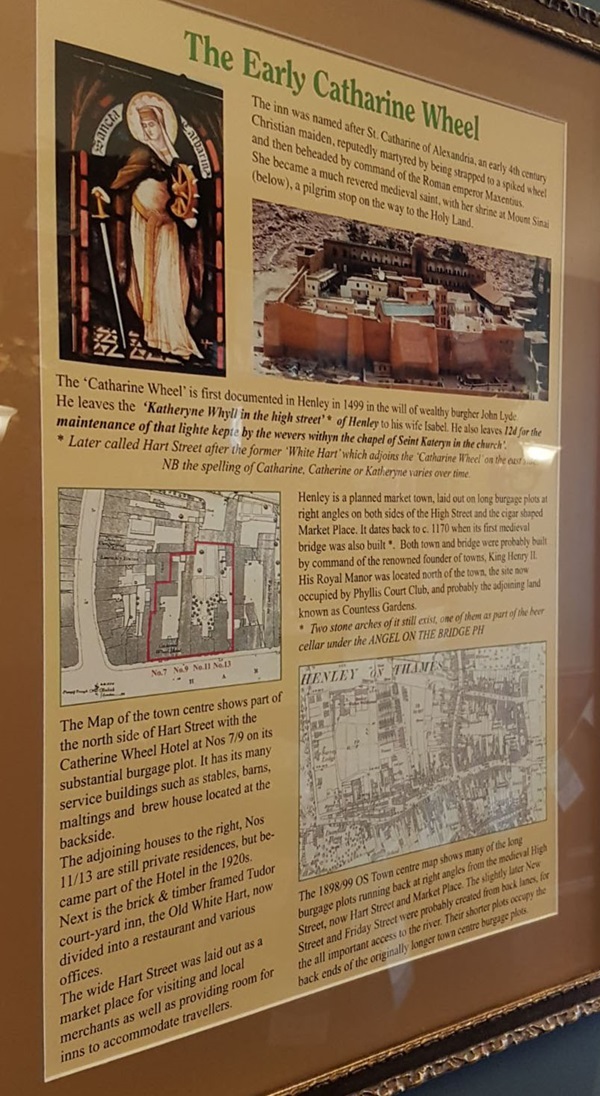
The text reads: The inn was named after St Catherine of Alexandria, an early 4th century Christian maiden, reputedly martyred by being strapped to a spiked wheel and then beheaded by command of the Roman emperor Maxentius. She became a much revered medieval saint, with her shrine at Mount Sinai (below), a pilgrim stop on the way to the Holy Land.
The Catherine Wheel is first documented in Henley in 1499 in the will of the wealthy burgher John Lyde. He leaves the “Katheryne Whyll on the high street” (later called Hart Street) of Henley to his wife Isabel. He also leaves “12d for the maintenance of that lighte kepte by the wevers withyn the chapel of Sent Kateryn in the church”.
Henley is a planned market town, laid out on long burgage plots at right angles on both sides of High Street and the cigar shaped Market Place. It dates back to c1170 when its first medieval bridge was also built (two stone arches of it still exist). Both town and bridge were probably built by command of the renowned founder of the towns, King Henry II. His Royal Manor was located north of the town, the site now occupied by Phyllis Court Club, and probably the adjoining land known as Countess Gardens.
The map of the town centre shows part of the north side of Hart Street with The Catherine Wheel Hotel at numbers 7-9 on its substantial burgage plot. It has many service buildings such as stables, barns maltings and a brew house located at the backside. The adjoining houses to the right, numbers 11-13 are still private residences, but became part of the hotel in the 1920s. Next is the brick and timber framed Tudor courtyard inn, the Old White Hart, now divided into a restaurant and various offices. The wide Hart Street was laid out as a market place for visiting and local merchants as well as providing room for inns to accommodate travellers.
The 1898-99 OS town centre map shows many of the long burgage plots running back at right angles from the medieval High Street, now Hart Street and Market Place. The slightly later New Street and Friday Street were probably created from back lanes, for the all important access to the river. Their shorter plots occupy the back ends of the originally longer town centre burgage plots.
Illustrations, photographs and text about The Catherine Wheel in the 17th century.
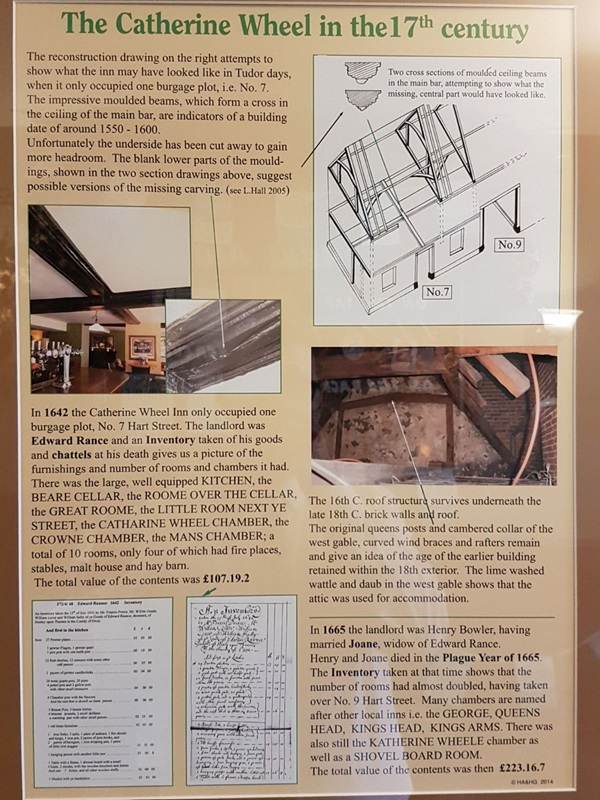
The text reads: The reconstruction drawing on the right attempts to show what the inn may have looked like in Tudor day, when it only occupied one burgage plot, i.e. No. 7. The impressive moulded beams, which form a cross in the ceiling of the main bar, are indicators of a building date of around 1550-1600. Unfortunately the underside has been cut away to gain more headroom. The blank lower parts of the mouldings, shown in the two section drawings above, suggest possible versions of the missing carving.
In 1642 The Catherine Wheel Inn only occupied one burgage plot, No. 7 Hart Street. The landlord was Edward Rance and an inventory taken of his goods and chattels at his death gives us a picture of the furnishings and number of rooms and chambers it had. There was the “large, well equipped kitchen, the beare cellar, the roome over the cellar, the great roome, the little room next ye street, the Catharine Wheel Chamber, the crowne chamber, the mans chamber”; a total of 10 rooms, only four of which had fire places, stables, malt house and hay barn. The total value of contents was £107,192.
The 16th century roof structure survives underneath the late 18th century brick walls. The original queens posts and cambered collar of the west gable, curved wind braces and rafters remain and give an idea of the age of the earlier building retained within the 18th exterior. The lime washed wattle and daub in the west gable shows that the attic was used for accommodation.
In 1665 the landlord was Henry Bowler, having married Joane, widow of Edward Rance. Henry and Joane died in the Plague Year of 1665. The inventory taken at that time shows that the number of rooms had almost doubled, having taken over No. 9 Hart Street. Many chambers are named after other local inns, i.e. The George, Queens Head, Kings Head and Kings Arms. There was also still The Katherine Wheele chamber as well as a shovel board room. The total value of the contents was then £223,167.
Photographs and text about The Catherine Wheel in the 19th and 20th century.
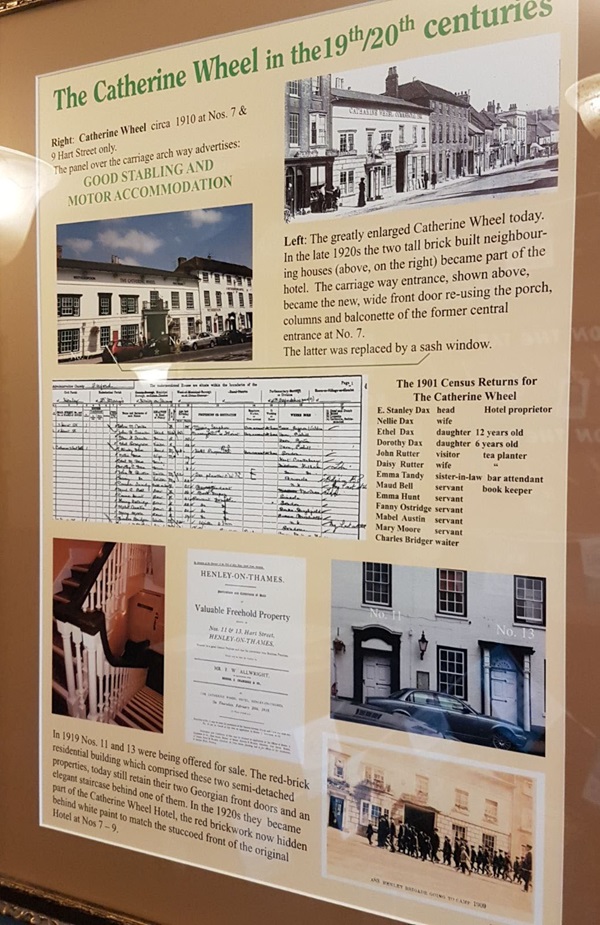
The text reads:
Right: The Catherine Wheel c1910 at numbers 7 and 9 Hart Street only. The panel over the carriage archway advertises ‘good stabling and motor accommodation’.
Left: The greatly enlarged Catherine Wheel today. In the late 1920s the two tall brick built neighbouring houses (above, on the right) became part of the hotel. The carriage way entrance, shown above, became the new, wide front door re-using the porch, columns and balconette of the former central entrance at No. 7. The latter was replaced by a sash window.
In 1919 numbers 11 and 13 were being offered for sale. The red brick residential building which comprised these two semi-detached properties, today still retain their two Georgian front doors and an elegant staircase behind one of them. In the 1920s they became part of The Catherine Wheel Hotel, the red brickwork now hidden behind white paint to match the stuccoed front of the original hotel at numbers 7 to 9.
A poster advertising the Jazz and Skiffle Ball held at The Catherine Wheel Hotel.
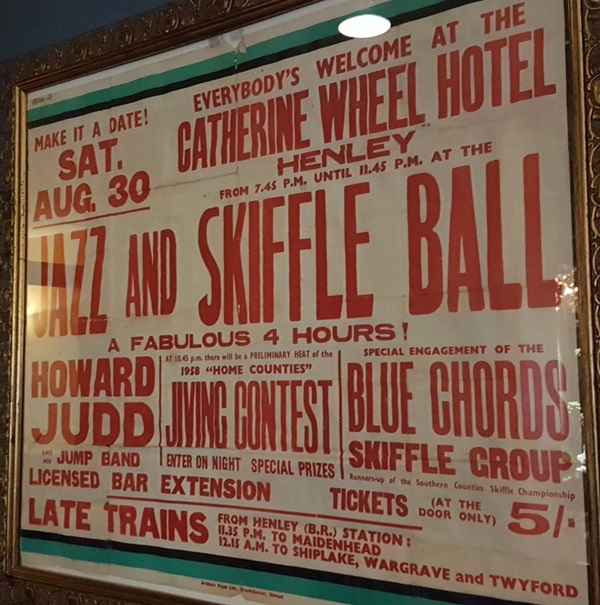
External photograph of the building – main entrance.
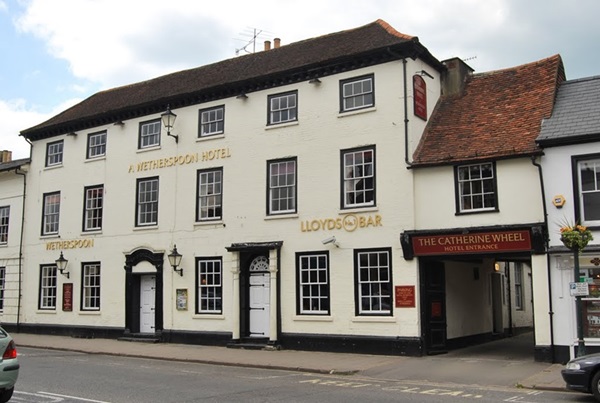
If you have information on the history of this pub, then we’d like you to share it with us. Please e-mail all information to: pubhistories@jdwetherspoon.co.uk